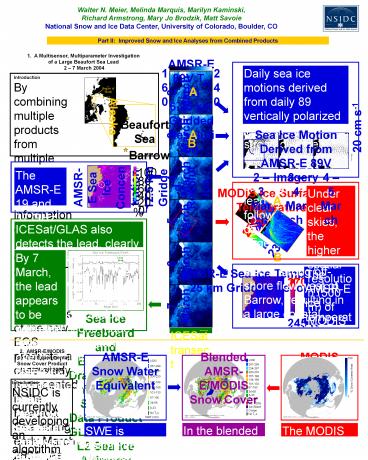Walter N. Meier, Melinda Marquis, Marilyn Kaminski, - PowerPoint PPT Presentation
1 / 1
Title:
Walter N. Meier, Melinda Marquis, Marilyn Kaminski,
Description:
... daily 89 vertically polarized TB fields show strong divergent motion west of ... The motion fields below encompass a larger region than the 89V images to show ... – PowerPoint PPT presentation
Number of Views:99
Avg rating:3.0/5.0
Title: Walter N. Meier, Melinda Marquis, Marilyn Kaminski,
1
Walter N. Meier, Melinda Marquis, Marilyn
Kaminski, Richard Armstrong, Mary Jo Brodzik,
Matt Savoie National Snow and Ice Data Center,
University of Colorado, Boulder, CO
Part II Improved Snow and Ice Analyses from
Combined Products
1. A Multisensor, Multiparameter Investigation
of a Large Beaufort Sea Lead 2 7 March 2004
AMSR-E 89V TB (K) 6.25 km Gridded Resolution
Daily sea ice motions derived from daily 89
vertically polarized TB fields show strong
divergent motion west of Barrow 2-4 March causing
the large lead (A) to form, followed the next day
by an even larger lead to the east (B). There is
also a strong off-shore flow west of Barrow,
resulting in a large coastal lead. Circulation
changes on 4-5 March turn the flow to an onshore
one and the lead starts closing. The motions are
estimated using a maximum cross-correlation
scheme that matches features in co-located image
pairs (Emery et al., 1991). The motion fields
below encompass a larger region than the 89V
images to show the overall circulation of the
surrounding region. The AMSR 89V image region
below is outlined in the blue box and the lead
(B) is denoted by the thick blue line.
240
160
Introduction By combining multiple products from
multiple sensors, more complete information on
sea ice processes can be obtained. To illustrate
such capabilities of the new EOS products, a
case-study is presented in the Beaufort Sea
during early March 2004. As seen in daily 89 GHz
imagery to the right, two large leads form in the
Beaufort Sea north of Barrow, Alaska. A large
coastal lead also forms to the west of Barrow.
The region of study is indicated in the maps to
the right. No single sensor or product can
retrieve all information of interest, but through
the combination of products from the three
sensors the lead opening and refreezing process
can be more completely investigated.
A
Region of Study
2 March
Sea Ice Motion Derived from AMSR-E 89V Imagery
A
3 March
B
20 cm s-1
The AMSR-E 19 and 37 GHz channels used for sea
ice concentration have a larger footprint and
thus cannot resolve the lead, except as a small
region of reduced ice concentration (circled).
It does resolve the larger coastal lead near
Barrow.
2 3 March
3 4 March
4 5 March
4 March
AMSR-E Sea Ice Concentration 12.5 km Gridded
Resolution
MODIS Ice Surface Temperature (Night)
Under clear skies, the higher spatial resolution
(500 m) of MODIS clearly detects the warmer
temperatures in the lead and resolves many
fracture features west (above the lead in the
image) of the lead in the zoomed region, the
cooler temperatures on the leeward side of the
lead indicate where freezing has begun. Clouds
contaminate temperatures east of the lead. The
large coastal lead is also clearly visible near
Barrow.
Clouds
5 March
ICESat/GLAS also detects the lead, clearly
visible as a thinner, smoother region. The
freeboard/draft was estimated from the sea ice
elevation product with corrections made for geoid
discrepancies. This is a simple correction and
ignores clouds and other possible error sources.
However, it does appear to yield a fair
representation of the ice cover, particularly the
lead.
By 7 March, the lead appears to be completely
frozen over. Using nearby Barrow air
temperatures from NOAA and Lebedevs ice growth
equation (based on freezing degree days) yields a
theoretical thickness of 0.16 m for the thinnest
ice in the lead, which is quite close to the
estimate from ICESat/GLAS the plot also shows
thicker ice on the leeward side of the lead where
ice growth has continued longer and where
rafting/ridging may be occurring.
6 March
AMSR-E Sea Ice Temperature 25 km Gridded
Resolution
The AMSR-E ice temperature algorithm does not
indicate any leads at all because of its use of
the low resolution 6.9 GHz channel. Thus, while
this field cannot directly be used to investigate
the lead, it can provide valuable information on
general conditions when clouds exist and
temperatures cannot be retrieved from MODIS (as
was the case on 6 March).
270 K
7 March
Sea Ice Freeboard and Estimated Draft Derived
from the Standard Data Product GLAS/ICESat L2 Sea
Ice Altimetry Data (GLA13)
245 K
ICESat transect
2. AMSR-E/MODIS Blended Experimental Snow Cover
Product 5 12 March 2004
Blended AMSR-E/MODIS Snow Cover
AMSR-E Snow Water Equivalent
MODIS Snow-Covered Area
100
300
300
267-299
267-299
234-267
234-267
200-233
167-199
200-233
Snow-Covered Area
134-166
Introduction NSIDC is currently developing an
algorithm to produce snow cover estimates using
combined data from both AMSR-E and MODIS. The
fields are 8-day composites, projected on the 25
km Northern Hemisphere EASE-Grid. By combining
estimates from AMSR-E snow water equivalent (SWE)
and MODIS snow-covered area fields more accurate
and more complete fields can be obtained.
167-199
101-133
67-100
134-166
34-66
101-133
8-33
1
67-100
SWE (mm)
34-66
Vis. 25
Ice Sheet
8-33
Ocean
No Tbs
No Tbs
SWE (mm)
In the blended product, regions with greater than
25 snow-covered area detected by MODIS
supplement AMSR-E SWE estimates.
The MODIS snow cover image is based on the
percentage of snow covered area detected by MODIS
over the 8-day period.
SWE is estimated from AMSR-E using a different
algorithm from the standard product (Armstrong
and Brodzik, 2001).































